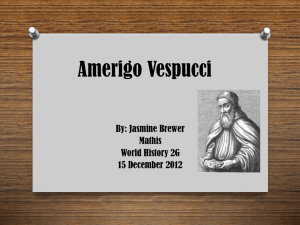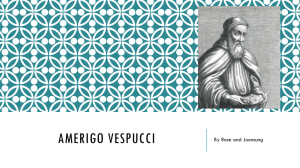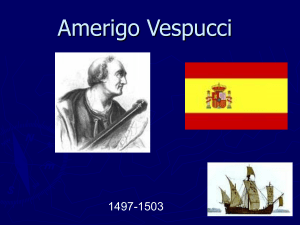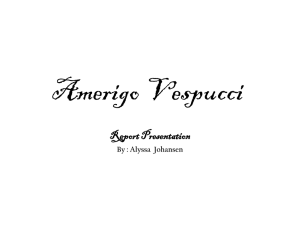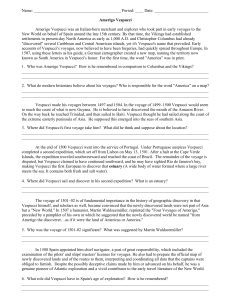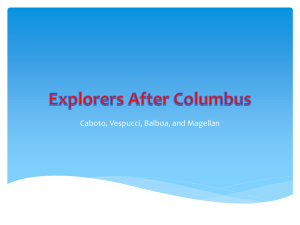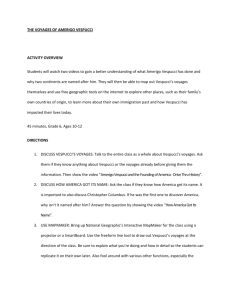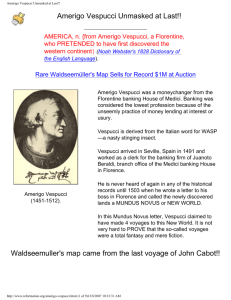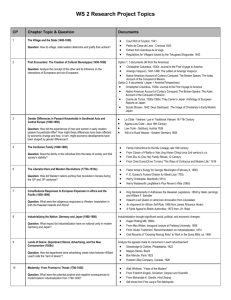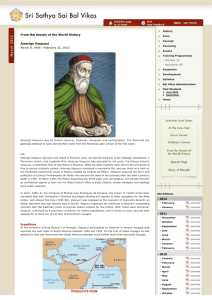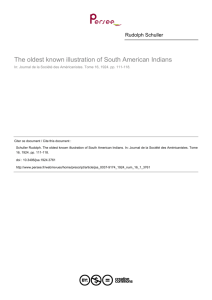ALLA CORRENTE Amerigo Vespucci
advertisement
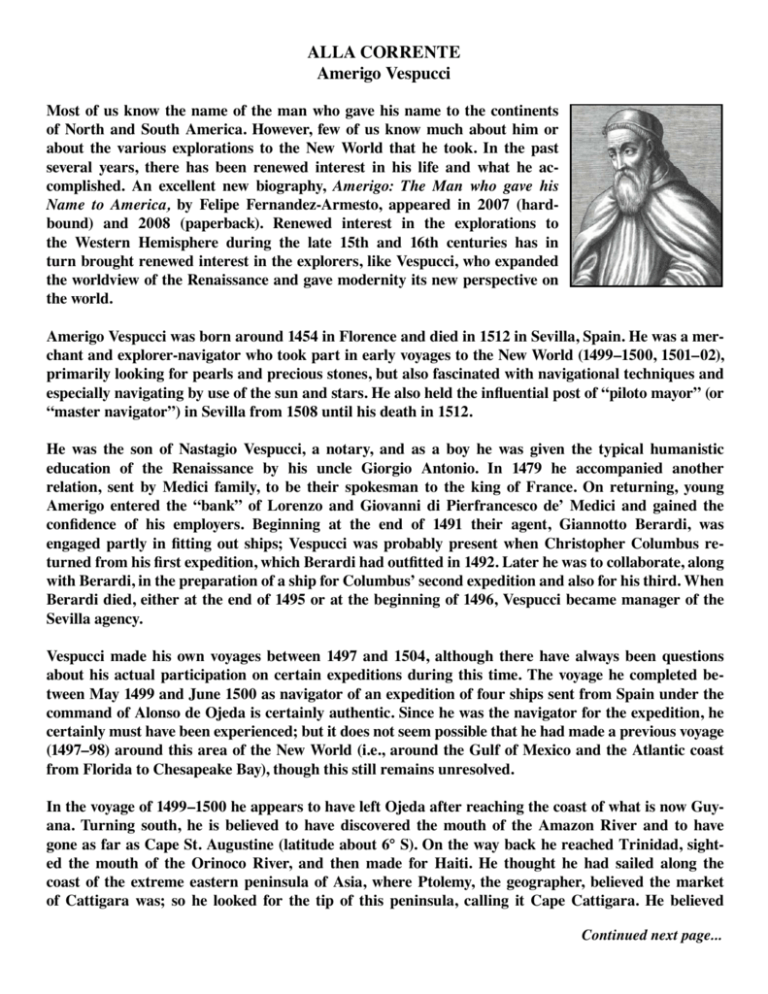
ALLA CORRENTE Amerigo Vespucci Most of us know the name of the man who gave his name to the continents of North and South America. However, few of us know much about him or about the various explorations to the New World that he took. In the past several years, there has been renewed interest in his life and what he accomplished. An excellent new biography, Amerigo: The Man who gave his Name to America, by Felipe Fernandez-Armesto, appeared in 2007 (hardbound) and 2008 (paperback). Renewed interest in the explorations to the Western Hemisphere during the late 15th and 16th centuries has in turn brought renewed interest in the explorers, like Vespucci, who expanded the worldview of the Renaissance and gave modernity its new perspective on the world. Amerigo Vespucci was born around 1454 in Florence and died in 1512 in Sevilla, Spain. He was a merchant and explorer-navigator who took part in early voyages to the New World (1499–1500, 1501–02), primarily looking for pearls and precious stones, but also fascinated with navigational techniques and especially navigating by use of the sun and stars. He also held the influential post of “piloto mayor” (or “master navigator”) in Sevilla from 1508 until his death in 1512. He was the son of Nastagio Vespucci, a notary, and as a boy he was given the typical humanistic education of the Renaissance by his uncle Giorgio Antonio. In 1479 he accompanied another relation, sent by Medici family, to be their spokesman to the king of France. On returning, young Amerigo entered the “bank” of Lorenzo and Giovanni di Pierfrancesco de’ Medici and gained the confidence of his employers. Beginning at the end of 1491 their agent, Giannotto Berardi, was engaged partly in fitting out ships; Vespucci was probably present when Christopher Columbus returned from his first expedition, which Berardi had outfitted in 1492. Later he was to collaborate, along with Berardi, in the preparation of a ship for Columbus’ second expedition and also for his third. When Berardi died, either at the end of 1495 or at the beginning of 1496, Vespucci became manager of the Sevilla agency. Vespucci made his own voyages between 1497 and 1504, although there have always been questions about his actual participation on certain expeditions during this time. The voyage he completed between May 1499 and June 1500 as navigator of an expedition of four ships sent from Spain under the command of Alonso de Ojeda is certainly authentic. Since he was the navigator for the expedition, he certainly must have been experienced; but it does not seem possible that he had made a previous voyage (1497–98) around this area of the New World (i.e., around the Gulf of Mexico and the Atlantic coast from Florida to Chesapeake Bay), though this still remains unresolved. In the voyage of 1499–1500 he appears to have left Ojeda after reaching the coast of what is now Guyana. Turning south, he is believed to have discovered the mouth of the Amazon River and to have gone as far as Cape St. Augustine (latitude about 6° S). On the way back he reached Trinidad, sighted the mouth of the Orinoco River, and then made for Haiti. He thought he had sailed along the coast of the extreme eastern peninsula of Asia, where Ptolemy, the geographer, believed the market of Cattigara was; so he looked for the tip of this peninsula, calling it Cape Cattigara. He believed Continued next page... ALLA CORRENTE, Continued Amerigo Vespucci that the ships, once they were past this point, would emerge into the seas of southern Asia. As soon as he was back in Spain, he equipped a fresh expedition to test this belief by trying to reach the Indian Ocean, the Gulf of the Ganges (modern Bay of Bengal), and the island of Taprobane or Ceylon (now Sri Lanka). But the Spanish government did not welcome his proposals, so at the end of 1500 he went into the service of Portugal. Under Portuguese auspices he started a second expedition, which set off from Lisbon on May 13, 1501. After a halt at the Cape Verde Islands, the expedition traveled southwestward and reached the coast of Brazil toward Cape St. Augustine. The remainder of the voyage is disputed, but Vespucci claimed to have continued southward, and he may have sighted (January 1502) Guanabara Bay (Rio de Janeiro’s bay) and sailed as far as the Río de la Plata, making him the first European to discover that estuary (Juan Díaz de Solís arrived there in 1516). The ships may have journeyed still farther south, along the coast of Patagonia. The return route is unknown, but ultimately Vespucci’s ships anchored at Lisbon on July 22, 1502. This voyage of 1501–02 is of fundamental importance in the history of geographic discovery because after the voyage, Vespucci himself, and scholars of the time as well, became convinced that the newly discovered lands were not part of Asia but of a “New World.” In 1507 a humanist, Martin Waldseemüller, reprinted in Lorraine the “Quattuor Americi navigationes” (“Four Voyages of Amerigo”), preceded by a pamphlet of his own in which he suggested that the newly discovered world be named “ab Americo Inventore…quasi Americi terram sive Americam” (“from Amerigo the discoverer…as if it were the land of Americus or America”). The proposal is perpetuated in a large planisphere of Waldseemüller’s, in which the name America appears for the first time, although applied only to South America. The suggestion caught on; the extension of the name to North America, however, came later. On the upper part of the map, with the hemisphere comprising the Old World, appears the picture of Ptolemy; on the part of the map with the New World hemisphere is the picture of Vespucci. Although Vespucci subsequently helped to prepare other expeditions, he never again joined one in person. At the beginning of 1505 he was summoned to the court of Spain for a private consultation and, as a “man of experience”, was engaged to work for the famous Casa de Contratación de las Indias (Commercial House for the Indies). In 1508 the house appointed him chief navigator, a post of great responsibility, which included the examination for licenses for voyages of pilots and ships’ masters. He also had to prepare the official map of newly discovered lands and of the routes to them (for the royal survey), interpreting and coordinating all data that the captains were obliged to furnish him. He held this position until his death, and his widow, Maria Cerezo, was granted a pension in recognition of her husband’s great services. Some scholars have held Vespucci to be a usurper of the merits of others. Yet, despite the possibly deceptive claims he made or advanced on his behalf, he was a genuine pioneer of Atlantic exploration. - Dr. James J. Boitano (Adapted from Britannica Online Encyclopedia)
